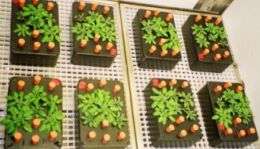How research into 'clocks' in plants could change our lives

(PhysOrg.com) -- From ensuring blooms for Mother’s Day to easing sleep disruption due to jet lag or shiftwork, new research into the ‘clocks’ in plants by a team of University of Glasgow plants scientists could have implications for the way we live our lives.
Life has evolved on a rotating Earth with alternating periods of light and darkness. As a result, most, perhaps all, organisms possess circadian (from the Latin ‘circa diem’ which means ‘about a day’) clocks that allow them not only to respond environmental changes but to anticipate them as well.
Living cells can ‘tell the time’ and use the information to control their behaviour. Humans also experience the circadian clock in the form of jetlag or sleeping problems associated with shiftwork. The phase of the clock can be advanced or delayed by signals called ‘zeitgebers’ and there is a lot of interest in developing light regimes or other treatments that will allow airline passengers to adapt more rapidly to changes in time zone.
Professor Hugh Nimmo, who led the research, said: “In plants the circadian clock contributes in several ways to optimal growth, and often controls flowering time which is vital for crop yield and the horticulture industry, for example, getting chrysanthemums to flower shortly before Mother’s Day. Developing a better understanding of the molecular mechanism of the circadian clock is of great importance both in human biology and for agriculture as the underlying ‘design principles’ seem to be the same in all higher organisms.
“Until now it has been widely accepted that all plant cells contain essentially identical circadian clocks, all synchronized in the same way by light but running independently of each other, with no communication between different cells or organs.
“Our results overturn this paradigm. Firstly, our data show that in plant roots the clock mechanism is surprisingly different from that in shoots. In roots only one of three interlocking ‘cogwheels’ is used, while the other two are disengaged. We also identified at least one of the biochemical causes of the difference. One consequence of the difference in clock mechanism is that the period of the root clock is about 1.5 hours longer than the period of the shoot clock in constant conditions. But our second finding is that, under normal day/night conditions, the shoots send a daily signal that synchronises the root clock, so the plant is properly coordinated. We have not identified this signal yet, but we know that it is related to photosynthesis.”
The data could have big implications for the field of chronobiology. The nature of circadian communication between organs is also very important in mammals. The ‘master clock’ in a part of the brain called the suprachiasmatic nucleus drives semi-autonomous ‘slave’ clocks in peripheral organs such as liver. And, specifically in the field of plant science, the data will be important in understanding the performance of roots, which take up all of the nutrients needed by the plant except carbon dioxide.
Professor Nimmo said: “Although we had worked on circadian rhythms of CO2 fixation for many years, we had not previously addressed the mechanism of the central circadian clock, which is a fiercely competitive area. Some of our earlier work (on soybean) suggested that the biochemical consequences of the central clock differ between shoots and roots.
“We obtained funding from the Leverhulme Trust to investigate this further using the model plant Arabidopsis. This background gave us a big advantage, because we were able to take a different approach to other groups. We use hydroponically-grown mature plants from which we can isolate shoots and roots separately. In contrast, most other groups have studied whole seedlings grown on agar plates. The results of our first experiment showed a fundamental difference in the machinery of the clock between shoots and roots. We had not predicted this in advance but we realized within a couple of days of getting the results just how important the data might be. Since then we have also discovered that shoots and roots communicate timing information. The next task will be to study the implication for crop species, for example the formation and growth of potato tubers.”
The team’s research is published in Science today (Friday 19 December 2008).
Source: University of Glasgow


















